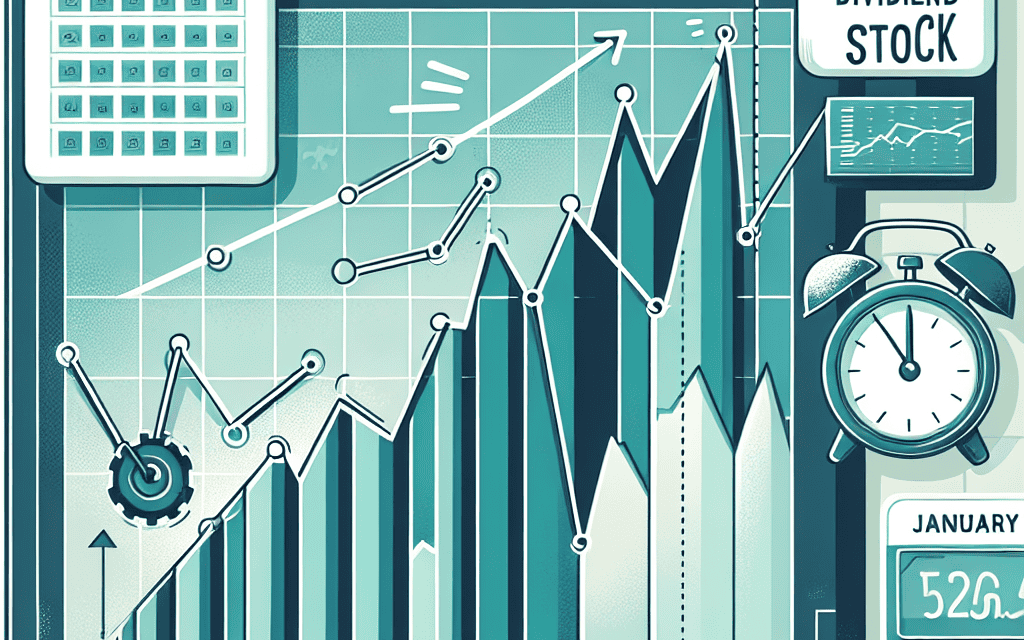“Navigating Uncertainty: Assessing Risks for High-Yield Dividends in January 2025”
Introduction
In January 2025, investors in high-yield dividend stocks may face a series of potential challenges that could impact their portfolios. As the global economic landscape continues to evolve, factors such as fluctuating interest rates, regulatory changes, and market volatility are likely to play significant roles in shaping the performance of these investments. Additionally, sector-specific issues, such as shifts in consumer demand and technological advancements, could further influence the stability and growth prospects of high-yield dividend stocks. Understanding these challenges is crucial for investors seeking to navigate the complexities of the market and make informed decisions about their investment strategies.
Interest Rate Fluctuations
As we approach January 2025, investors with a keen eye on high-yield dividend stocks are increasingly concerned about the potential challenges posed by interest rate fluctuations. These fluctuations can significantly impact the attractiveness and performance of dividend-paying stocks, particularly those offering high yields. Understanding the dynamics between interest rates and dividend stocks is crucial for investors aiming to navigate the complexities of the financial markets effectively.
To begin with, interest rates and dividend stocks are intricately linked. When interest rates rise, fixed-income investments such as bonds become more attractive due to their relatively lower risk compared to equities. Consequently, investors may shift their portfolios away from dividend stocks, which can lead to a decline in their prices. This inverse relationship is particularly pronounced for high-yield dividend stocks, as their appeal diminishes when safer alternatives offer comparable returns. Therefore, any anticipated increase in interest rates could pose a significant challenge for these stocks in the coming months.
Moreover, the Federal Reserve’s monetary policy plays a pivotal role in shaping interest rate trends. As the central bank adjusts its policy stance in response to economic indicators such as inflation and employment, interest rates may fluctuate accordingly. In recent years, the Federal Reserve has adopted a more data-driven approach, closely monitoring economic conditions to determine the appropriate course of action. As a result, any unexpected changes in economic data could lead to sudden shifts in interest rate expectations, thereby affecting the performance of high-yield dividend stocks.
In addition to the direct impact of interest rate changes, there are also indirect effects to consider. For instance, rising interest rates can increase borrowing costs for companies, potentially affecting their profitability and, by extension, their ability to maintain or grow dividend payouts. Companies with high levels of debt may find it particularly challenging to sustain their dividend payments in a rising interest rate environment. This scenario underscores the importance of evaluating a company’s financial health and debt levels when assessing the sustainability of its dividend yield.
Furthermore, interest rate fluctuations can influence investor sentiment and market volatility. As rates rise, the cost of capital increases, which can lead to reduced corporate investment and slower economic growth. This environment may create uncertainty in the stock market, prompting investors to reassess their risk tolerance and investment strategies. High-yield dividend stocks, often perceived as a source of stable income, may experience heightened volatility as investors react to changing market conditions.
Despite these challenges, it is essential to recognize that not all high-yield dividend stocks will be equally affected by interest rate fluctuations. Companies with strong fundamentals, robust cash flows, and a history of consistent dividend payments may be better positioned to weather the storm. Additionally, sectors such as utilities and consumer staples, which are traditionally less sensitive to economic cycles, may offer some resilience in a rising interest rate environment.
In conclusion, while interest rate fluctuations present potential challenges for high-yield dividend stocks in January 2025, investors can mitigate these risks by conducting thorough research and maintaining a diversified portfolio. By understanding the interplay between interest rates and dividend stocks, investors can make informed decisions that align with their financial goals and risk tolerance. As the financial landscape continues to evolve, staying informed and adaptable will be key to navigating the challenges and opportunities that lie ahead.
Regulatory Changes
As we look towards January 2025, investors in high-yield dividend stocks are keenly aware of the potential challenges that regulatory changes may pose. The landscape of financial regulations is ever-evolving, and companies that offer high-yield dividends are particularly susceptible to shifts in policy. These changes can significantly impact their financial performance and, consequently, their ability to maintain attractive dividend payouts. Therefore, understanding the regulatory environment is crucial for investors who rely on these stocks for steady income.
One of the primary concerns is the possibility of increased regulatory scrutiny on industries that traditionally offer high-yield dividends, such as utilities, telecommunications, and real estate investment trusts (REITs). These sectors are often heavily regulated due to their essential nature and widespread impact on the economy. As governments worldwide continue to focus on sustainability and consumer protection, new regulations could impose additional compliance costs on these companies. For instance, stricter environmental regulations could require utility companies to invest heavily in cleaner technologies, potentially diverting funds away from dividend distributions.
Moreover, the global push towards digitalization and data privacy is likely to result in more stringent regulations for telecommunications companies. As these firms invest in infrastructure to support 5G networks and other technological advancements, they may face increased regulatory oversight to ensure data security and consumer privacy. This could lead to higher operational costs, which might affect their profitability and, by extension, their ability to sustain high dividend yields.
In addition to industry-specific regulations, broader financial regulations could also pose challenges. For example, changes in tax policies can have a direct impact on dividend-paying companies. If governments decide to increase corporate tax rates or alter the tax treatment of dividends, companies may find it more difficult to maintain their current payout levels. This is particularly relevant in jurisdictions where dividend income is taxed at a higher rate than capital gains, as it could discourage investment in high-yield dividend stocks.
Furthermore, the potential for interest rate hikes by central banks in response to inflationary pressures could also influence the regulatory environment. Higher interest rates generally lead to increased borrowing costs for companies, which can strain their financial resources. For high-yield dividend stocks, which often rely on debt to finance their operations and growth, this could mean reduced cash flow available for dividends. Additionally, regulatory bodies might introduce measures to curb excessive borrowing, further complicating the financial strategies of these companies.
While these regulatory challenges are significant, it is important to note that companies offering high-yield dividends have historically demonstrated resilience in the face of adversity. Many of these firms have strong balance sheets and experienced management teams capable of navigating complex regulatory landscapes. However, investors must remain vigilant and proactive in assessing how potential regulatory changes could affect their investments. By staying informed and adapting their strategies accordingly, they can better position themselves to mitigate risks and capitalize on opportunities.
In conclusion, as we approach January 2025, the regulatory environment presents both challenges and opportunities for high-yield dividend stocks. While increased scrutiny and potential policy shifts could impact these companies’ financial performance, a thorough understanding of the regulatory landscape can help investors make informed decisions. By carefully monitoring developments and adjusting their portfolios as needed, investors can continue to benefit from the income-generating potential of high-yield dividend stocks while navigating the complexities of an evolving regulatory framework.
Market Volatility
As we look towards January 2025, investors with a keen interest in high-yield dividend stocks are likely to face a landscape marked by significant market volatility. This volatility, while not uncommon in the financial markets, presents a unique set of challenges for those invested in high-yield dividend stocks. These stocks, often favored for their ability to provide steady income streams, may encounter headwinds that could impact their performance and, consequently, the returns for investors.
One of the primary factors contributing to market volatility is the ongoing uncertainty in global economic conditions. As economies worldwide continue to recover from the disruptions caused by the pandemic, uneven growth patterns have emerged. Some regions are experiencing robust economic expansion, while others are grappling with slower recovery rates. This disparity can lead to fluctuations in currency values, trade imbalances, and shifts in consumer demand, all of which can affect the performance of dividend-paying companies. For instance, companies with significant international exposure may find their earnings impacted by unfavorable exchange rates or geopolitical tensions, thereby influencing their ability to maintain or increase dividend payouts.
Moreover, the potential for interest rate adjustments by central banks adds another layer of complexity. In recent years, central banks have adopted accommodative monetary policies to support economic recovery, resulting in historically low interest rates. However, as inflationary pressures build, there is a growing expectation that central banks may begin to tighten monetary policy by raising interest rates. Such actions could lead to increased borrowing costs for companies, potentially squeezing profit margins and affecting their capacity to sustain high dividend yields. Additionally, higher interest rates may make fixed-income investments more attractive, prompting some investors to reallocate their portfolios away from dividend stocks.
In addition to macroeconomic factors, sector-specific challenges could also contribute to market volatility for high-yield dividend stocks. For example, the energy sector, which includes many high-yield dividend payers, faces ongoing challenges related to the transition towards renewable energy sources. As governments and corporations worldwide commit to reducing carbon emissions, traditional energy companies may encounter regulatory pressures and shifting consumer preferences. These dynamics could impact their profitability and, by extension, their ability to deliver consistent dividends.
Furthermore, technological advancements and changing consumer behaviors are reshaping industries at an unprecedented pace. Companies that fail to adapt to these changes may find themselves at a competitive disadvantage, potentially affecting their financial performance and dividend sustainability. Investors must remain vigilant and assess whether the companies they are invested in are well-positioned to navigate these transformative trends.
Despite these challenges, it is important to note that high-yield dividend stocks have historically demonstrated resilience in the face of market volatility. Their ability to provide regular income can offer a degree of stability during turbulent times. However, investors should exercise caution and conduct thorough due diligence when selecting dividend stocks, considering factors such as the company’s financial health, dividend history, and growth prospects.
In conclusion, while high-yield dividend stocks remain an attractive option for income-seeking investors, the potential challenges posed by market volatility in January 2025 cannot be overlooked. By staying informed about macroeconomic trends, sector-specific developments, and individual company performance, investors can better position themselves to navigate the uncertainties ahead and make informed decisions that align with their financial goals.
Economic Recession Risks

As we look towards January 2025, investors are increasingly concerned about the potential challenges facing high-yield dividend stocks, particularly in the context of looming economic recession risks. The global economic landscape is fraught with uncertainties, and these uncertainties could significantly impact the performance of dividend stocks that have traditionally been seen as safe havens for income-seeking investors. Understanding the interplay between economic conditions and dividend stock performance is crucial for making informed investment decisions.
One of the primary concerns is the potential for an economic recession, which could be triggered by a variety of factors, including geopolitical tensions, supply chain disruptions, and fluctuating interest rates. Historically, recessions have led to reduced corporate earnings, which in turn can pressure companies to cut or suspend their dividend payments. For high-yield dividend stocks, which are often favored for their steady income streams, this scenario poses a significant risk. Investors may find themselves grappling with the dual challenges of declining stock prices and reduced dividend income, undermining the very rationale for holding these investments.
Moreover, the current macroeconomic environment is characterized by high inflation rates, which central banks around the world are attempting to combat through monetary tightening. Rising interest rates can have a twofold impact on high-yield dividend stocks. Firstly, they increase the cost of borrowing for companies, potentially squeezing profit margins and limiting the ability to maintain or grow dividend payouts. Secondly, higher interest rates make fixed-income securities more attractive, potentially leading to a shift in investor preference away from dividend stocks towards bonds and other interest-bearing assets. This shift could result in downward pressure on the stock prices of high-yield dividend companies, further exacerbating the challenges faced by investors.
In addition to these macroeconomic factors, sector-specific challenges also loom large. Many high-yield dividend stocks are concentrated in sectors such as utilities, real estate, and consumer staples, which are traditionally seen as defensive plays. However, these sectors are not immune to the broader economic challenges. For instance, utility companies may face regulatory pressures and increased operational costs, while real estate investments could be impacted by changing work patterns and consumer behaviors in a post-pandemic world. Consumer staples, while generally resilient, may still experience margin pressures due to rising input costs and shifting consumer preferences.
Furthermore, the global push towards sustainability and environmental, social, and governance (ESG) considerations is reshaping the investment landscape. Companies that fail to adapt to these evolving expectations may find themselves at a competitive disadvantage, potentially affecting their long-term profitability and ability to sustain dividend payments. Investors must therefore be vigilant in assessing the ESG credentials of high-yield dividend stocks, as these factors are increasingly influencing investment decisions and corporate valuations.
In conclusion, while high-yield dividend stocks have traditionally been viewed as reliable income-generating investments, the potential challenges ahead in January 2025 cannot be overlooked. Economic recession risks, coupled with rising interest rates and sector-specific pressures, present a complex set of challenges that could impact the performance of these stocks. Investors must remain vigilant, continuously reassessing their portfolios and staying informed about macroeconomic trends and sectoral developments. By doing so, they can better navigate the uncertainties and position themselves to weather potential storms in the investment landscape.
Competitive Pressures
As we look toward January 2025, investors in high-yield dividend stocks are keenly aware of the competitive pressures that could impact their portfolios. One such stock, which has historically been a reliable source of income, is now facing a series of challenges that could affect its performance. Understanding these competitive pressures is crucial for investors who rely on dividends as a significant component of their investment strategy.
To begin with, the industry in which this high-yield dividend stock operates is becoming increasingly saturated. New entrants, armed with innovative technologies and fresh capital, are eager to capture market share. This influx of competition can lead to price wars, which may erode profit margins. Established companies, including our subject stock, may find it difficult to maintain their pricing power, which is essential for sustaining high dividend payouts. Consequently, investors should be vigilant about how these dynamics could influence the company’s ability to generate consistent cash flow.
Moreover, technological advancements are reshaping the landscape, compelling traditional players to adapt swiftly or risk obsolescence. Companies that fail to invest in new technologies may find themselves at a disadvantage, as competitors leverage these innovations to enhance efficiency and customer experience. For the high-yield dividend stock in question, this means that significant capital expenditures may be necessary to stay competitive. While such investments are crucial for long-term viability, they could strain the company’s financial resources in the short term, potentially impacting its ability to maintain or increase dividend payments.
In addition to technological challenges, regulatory changes pose another layer of complexity. Governments worldwide are increasingly focused on implementing stringent regulations to address environmental, social, and governance (ESG) concerns. For companies in certain sectors, this could mean higher compliance costs and the need to overhaul existing practices. The high-yield dividend stock under discussion may face increased scrutiny and pressure to align with these evolving standards. While aligning with ESG principles can enhance a company’s reputation and appeal to socially conscious investors, the associated costs could weigh on profitability and, by extension, dividend sustainability.
Furthermore, macroeconomic factors cannot be overlooked. Interest rate fluctuations, for instance, can have a profound impact on high-yield dividend stocks. Rising interest rates often lead to higher borrowing costs, which can squeeze profit margins. Additionally, as interest rates rise, fixed-income investments become more attractive, potentially leading investors to shift away from dividend stocks in search of safer returns. This shift in investor sentiment could result in decreased demand for the stock, putting downward pressure on its price.
Lastly, global supply chain disruptions continue to be a concern. The lingering effects of the COVID-19 pandemic, geopolitical tensions, and natural disasters have highlighted vulnerabilities in supply chains. For companies reliant on complex global networks, these disruptions can lead to production delays and increased costs. The high-yield dividend stock in question may need to navigate these challenges carefully to ensure that its operations remain efficient and its financial performance remains robust.
In conclusion, while high-yield dividend stocks have traditionally been a staple for income-focused investors, the competitive pressures facing these investments in January 2025 are multifaceted. From increased competition and technological advancements to regulatory changes and macroeconomic factors, investors must remain vigilant and informed. By understanding these challenges, they can make more informed decisions about their portfolios and better assess the sustainability of their dividend income.
Currency Exchange Impacts
As investors look towards January 2025, the high-yield dividend stock in question faces a myriad of potential challenges, particularly in the realm of currency exchange impacts. This issue is of paramount importance, as fluctuations in currency values can significantly affect the profitability and dividend-paying capacity of companies with international operations. To begin with, the global economic landscape is currently characterized by volatility, with various geopolitical tensions and economic policies influencing currency markets. Consequently, companies that derive a substantial portion of their revenue from overseas markets are particularly vulnerable to these fluctuations.
For this high-yield dividend stock, which has a considerable international presence, the strength of the U.S. dollar against other currencies is a critical factor. A strong dollar can erode the value of foreign earnings when they are repatriated, thereby reducing the overall revenue and potentially impacting the company’s ability to maintain its high dividend payouts. Moreover, the exchange rate volatility can also affect the cost structure of the company, especially if it relies on importing raw materials or components priced in foreign currencies. This could lead to increased operational costs, further squeezing profit margins.
In addition to these direct impacts, currency exchange rates can also influence investor sentiment and stock valuation. A company that is perceived to be at risk due to adverse currency movements may see its stock price decline, as investors seek to mitigate potential losses. This, in turn, can affect the company’s market capitalization and its ability to raise capital for future growth initiatives. Furthermore, the uncertainty surrounding currency fluctuations can lead to increased market volatility, which may deter risk-averse investors from holding or acquiring shares in the company.
To mitigate these challenges, companies often employ hedging strategies to protect against adverse currency movements. However, these financial instruments come with their own set of risks and costs, which can impact the company’s financial performance. Additionally, the effectiveness of hedging strategies can vary, depending on the accuracy of the company’s forecasts and the dynamic nature of currency markets. Therefore, while hedging can provide some level of protection, it is not a foolproof solution.
Another potential challenge is the impact of monetary policy decisions by central banks around the world. Interest rate changes can have a profound effect on currency values, and with several central banks adopting divergent monetary policies, predicting currency movements becomes increasingly complex. For instance, if the Federal Reserve decides to raise interest rates while other central banks maintain or lower theirs, the U.S. dollar could strengthen further, exacerbating the challenges faced by this high-yield dividend stock.
In conclusion, as January 2025 approaches, the high-yield dividend stock must navigate a complex web of currency exchange impacts. The interplay between currency fluctuations, operational costs, investor sentiment, and monetary policy decisions presents a formidable challenge. While hedging strategies offer some respite, they are not without limitations. Therefore, investors and company management alike must remain vigilant and adaptable, continuously assessing the evolving economic landscape to safeguard the company’s financial health and its ability to deliver consistent dividend payouts. As such, understanding and managing currency exchange impacts will be crucial for the company’s success in the coming year.
Dividend Sustainability Concerns
As investors look towards January 2025, the sustainability of high-yield dividend stocks remains a topic of considerable interest and concern. Among these, one particular stock has garnered attention due to its impressive dividend yield, which has been a significant draw for income-focused investors. However, beneath the allure of high returns lies a series of potential challenges that could impact the stock’s ability to maintain its dividend payouts. Understanding these challenges is crucial for investors who rely on dividends as a steady source of income.
To begin with, the company’s financial health is a primary factor influencing its dividend sustainability. While the stock has historically delivered robust dividends, recent financial reports suggest a tightening of profit margins. This contraction can be attributed to increased operational costs and competitive pressures within the industry. As a result, the company’s ability to generate sufficient free cash flow, which is essential for funding dividend payments, may be compromised. Consequently, investors should closely monitor the company’s earnings reports and cash flow statements to assess whether it can continue to support its high dividend yield.
Moreover, the broader economic environment plays a pivotal role in shaping the prospects of high-yield dividend stocks. With the global economy facing potential headwinds, such as rising interest rates and geopolitical tensions, companies may encounter challenges in maintaining their growth trajectories. Higher interest rates, in particular, can increase borrowing costs, thereby squeezing profit margins further. For companies with significant debt obligations, this scenario could lead to a reallocation of resources away from dividend payments towards debt servicing, thereby threatening dividend sustainability.
In addition to economic factors, regulatory changes can also pose risks to dividend sustainability. The industry in which this high-yield stock operates is subject to stringent regulations that can impact its operational flexibility and profitability. Any changes in regulatory policies, such as increased compliance costs or restrictions on certain business practices, could adversely affect the company’s financial performance. Investors should remain vigilant about potential regulatory developments and consider their implications for the company’s ability to sustain its dividend payouts.
Furthermore, the company’s strategic decisions and management effectiveness are critical determinants of its dividend sustainability. While management may prioritize maintaining high dividend yields to attract and retain investors, this strategy must be balanced with the need for reinvestment in the business. Failure to invest adequately in innovation, infrastructure, and market expansion could hinder the company’s long-term growth prospects, ultimately affecting its capacity to sustain dividends. Therefore, investors should evaluate the company’s strategic initiatives and management’s track record in executing them effectively.
Lastly, market sentiment and investor behavior can influence the stock’s performance and, by extension, its dividend sustainability. In times of market volatility, investor confidence can waver, leading to fluctuations in stock prices. A significant decline in the stock’s market value could pressure the company to adjust its dividend policy to preserve capital. Thus, understanding market dynamics and investor sentiment is essential for assessing the potential risks to dividend sustainability.
In conclusion, while this high-yield dividend stock offers attractive returns, several challenges could impact its ability to maintain dividend payouts in January 2025. Investors should consider the company’s financial health, economic conditions, regulatory environment, strategic decisions, and market sentiment when evaluating the sustainability of its dividends. By staying informed and vigilant, investors can make more informed decisions and better manage the risks associated with high-yield dividend stocks.
Q&A
1. **Question:** What regulatory changes could impact the high-yield dividend stock in January 2025?
**Answer:** Potential regulatory changes, such as increased taxation on dividends or stricter industry regulations, could impact the profitability and dividend payout of the stock.
2. **Question:** How might interest rate fluctuations affect the high-yield dividend stock?
**Answer:** Rising interest rates could make bonds more attractive compared to dividend stocks, potentially leading to a decrease in the stock’s price and demand.
3. **Question:** What economic conditions could pose a challenge to the high-yield dividend stock?
**Answer:** An economic downturn or recession could reduce the company’s earnings, leading to potential dividend cuts or suspensions.
4. **Question:** How could changes in consumer behavior impact the high-yield dividend stock?
**Answer:** Shifts in consumer preferences away from the company’s products or services could decrease revenue and affect dividend sustainability.
5. **Question:** What operational risks might the company face that could affect its dividend payouts?
**Answer:** Operational risks such as supply chain disruptions, increased production costs, or management inefficiencies could impact profitability and dividend payments.
6. **Question:** How might competition influence the high-yield dividend stock’s performance?
**Answer:** Increased competition could lead to market share loss, pricing pressures, and reduced margins, potentially affecting the company’s ability to maintain high dividend yields.
7. **Question:** What geopolitical factors could present challenges for the high-yield dividend stock?
**Answer:** Geopolitical tensions, trade wars, or sanctions could disrupt international operations and supply chains, impacting the company’s financial health and dividend policy.
Conclusion
In January 2025, potential challenges for a high-yield dividend stock may include rising interest rates, which could make dividend stocks less attractive compared to fixed-income securities. Additionally, economic downturns or sector-specific issues could impact the company’s revenue and profitability, potentially leading to dividend cuts. Regulatory changes and increased competition might also pressure margins. Furthermore, if the company has high debt levels, it may face difficulties in maintaining dividend payouts amidst tightening credit conditions. Investors should closely monitor these factors to assess the sustainability of the dividend yield.





